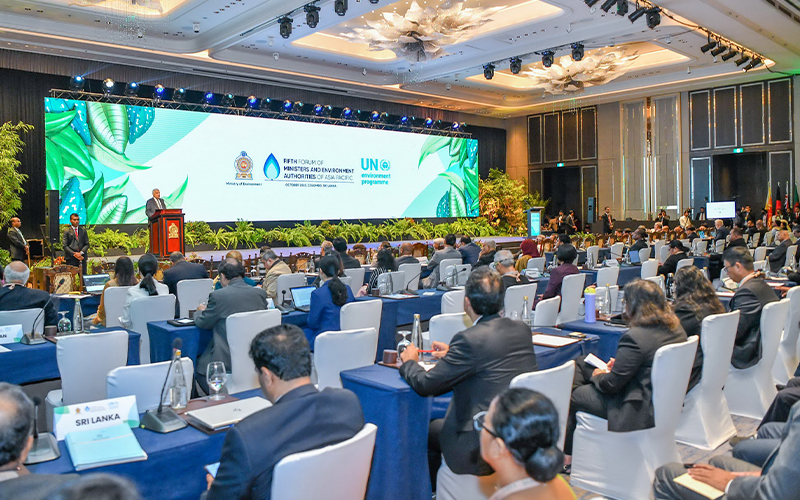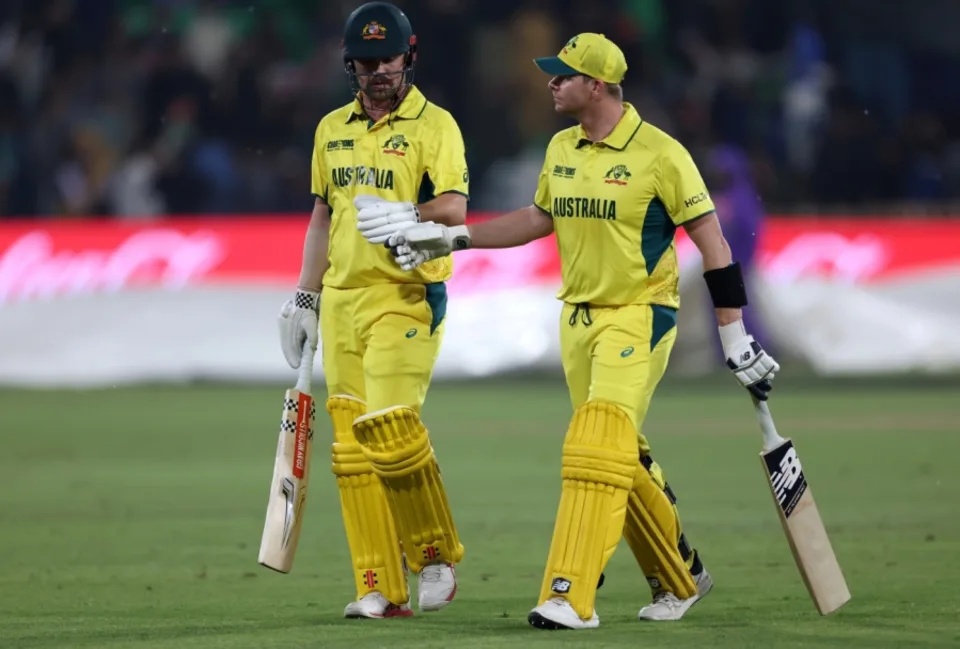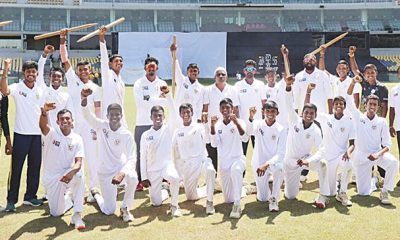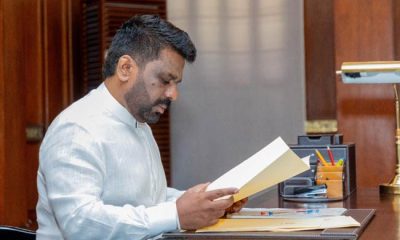Latest News
President Wickremesinghe warns of climate crisis and unveils ambitious plans

President Ranil Wickremesinghe addressed the 5th Forum of Ministers & Environment Authorities of the Asia Pacific at the Shangri La Hotel in Colombo today (05), delivering a passionate speech that emphasized three crucial points: the urgency of the climate crisis, Sri Lanka’s ambitious climate plans and the dire state of global biodiversity.
President Wickremesinghe opened his speech by drawing attention to the pressing climate concerns facing the world today. He cited the alarming estimate from the Intergovernmental Panel on Climate Change (IPCC), stating that global warming is projected to reach a dangerous 1.5 degrees Celsius between 2030 and 2052. “Humanity is facing an existential threat,” he declared. He highlighted the interlinked crises of climate change, biodiversity loss and pollution, emphasizing the devastating impact on individuals and communities worldwide.
The President then turned to Sri Lanka’s commitment to addressing these challenges. He pledged to accelerate nature-based solutions, including renewable energy, through Sri Lanka’s Climate Prosperity Plan, which was launched at COP 27. “Sri Lanka is in the process of renewing the National Biodiversity Strategic Action Plan 2016 to 2022 to achieve the objectives of the Kunming-Montreal Global Diversity Framework,” he announced. Additionally, he unveiled an ambitious Net Zero 2050 roadmap for Sri Lanka, set to be launched at COP 28.
President Wickremesinghe stressed that despite Sri Lanka’s minor global emissions contribution (0.03%), the country is dedicated to significant reductions. Sri Lanka aims to achieve a 14.5% reduction in greenhouse gas emissions by 2030, generate 70% of its electricity from renewable sources, attain a 32% forest cover, phase out coal power by 2042, and reach net-zero emissions by 2050.
The President also expressed deep concern over the state of global biodiversity. He lamented that the world has already lost 8% of known animal species, with 22% at risk of extinction due to habitat destruction and invasive species. “We are now losing biodiversity up to 10,000 times faster than it was disappearing 100 years ago,” he warned.
In conclusion, President Wickremesinghe’s speech outlined the urgent need for climate action, Sri Lanka’s commitment to sustainability and the critical biodiversity challenges the world faces. The President’s call for collective action and his unveiling of ambitious climate plans underscored the gravity of the global situation.“Countries unwilling to do their part to stop the climate crisis are guilty of committing genocide,” he concluded.
Following is the full speech delivered by President Ranil Wickremesinghe at the 5th Forum of Ministers & Environment Authorities of the Asia Pacific;
“I join our Minister of Environment in welcoming you to Sri Lanka. Humanity is facing an existential threat. The interlinked and cascading effects of climate change, biodiversity loss, and pollution—the triple planetary crisis—are demanding a heavy toll on individuals, communities and threatening life on our planet. We are putting extreme pressure on the planet. The triple planetary crisis is already exceeding the planetary boundaries. The world has already lost 8% of known animal species and 22% are at risk of extinction due to the destruction of their natural habitats and the introduction of invasive species. We are now losing biodiversity up to 10,000 times faster than it was disappearing 100 years ago. Declines in nature and biodiversity at the current trajectory will undermine the progress towards 35 out of 44 targets of the SDGs related to poverty, hunger, health, weather, cities, climates, oceans and land. In terms of change, the Intergovernmental Panel on Climate Change estimates that global warming is likely to reach 1.5 degrees Celsius between 2030 and 2052.
The other day, I read a blog by a young scientist, a member of the Union of Concerned Scientists. Her name is Sanjali De Silva. This is what she said: “People of Sri Lanka feel the impact of climate change every day. Those effects are overwhelmingly caused by the self-serving command and irresponsible action of the fossil fuel industry and the nations unwilling to do their part to stop the climate paradigm. My people of Sri Lanka and my family deserve better.” I agree wholeheartedly with her. Sri Lanka, her country and mine, has constantly been placed among the top risk of extreme weather events by the Climate Risk Index annually released by German Watch. Although Sri Lanka’s emissions are globally negligible, amounting to merely 0.03%, we, in our ambitious NDCs, have set targets for 2030 to achieve a 14.5% reduction of GHG emissions, a 70% electricity generation through renewable sources, 32% forest cover, weaning off coal power by 2042 and reaching net zero by 2050.
The Climate Prosperity Plan of Sri Lanka, launched at COP 27, aims at rapid augmentation of nature-based solutions, including renewable energy. The Net Zero 2050 roadmap for Sri Lanka will be launched at COP 28. Sri Lanka is in the process of renewing the National Biodiversity Strategic Action Plan 2016 to 2022 to achieve the objectives of the Kunming-Montreal Global Diversity Framework. Since Sri Lanka is one of the 36 global biodiversity hotspots, I have instructed the Ministry of Environment to formulate a national policy on living entities to conserve pristine ecosystems. Sri Lanka has formulated the national policy on waste management, covering nine categories of general and hazardous waste. The national policy on chemical management was formulated to streamline chemical management in the country. Sri Lanka formulated the national policy on sustainable consumption and production in 2019. The Green Procurement Policy and the Green Labelling Framework will come into effect this year. My government will enact a new Climate Change Act and a National Environment Act to address the triple planetary crisis in the context of new knowledge and practices. We are starting our transition to a green economy. But there is a cost. The Climate Prosperity Plan, which spans from 2023 to 2042, will require 26.5 billion U.S. dollars. The implementation of the Net Zero 2050 roadmap will require over 100 billion U.S. dollars. The list is not over. Where are we going to source these resources from? We cannot source all this money from within our country. The problem is not confined to Sri Lanka.
Developing countries require financing up to 5.9 trillion U.S. dollars to fulfill their NDCs up to 2030. A further 4 trillion U.S. dollars is required per annum for clean energy technology to achieve net zero emissions by 2050. At COP 27, there was an agreement to provide the lost and damaged funding for vulnerable countries hit by climate disaster. The Sharm El Sheikh Implementation Plan, a transitional committee was established. The meetings of the committee and the discussions at the recent sessions of the UN during the UN General Assembly have not resolved key questions.
a. Who will contribute? Is it the developed nations? EU, UK, Norway, among others, say all countries are liable to pay.
b. The question of criteria. Who will receive the funds?
c. Where to house the fund? At the World Bank or UNFCC?
d. Where do you find the money for the fund? Is it re-channelling existing funds or new additional funds? Delegates, these discussions are getting nowhere and it’s unlikely that these issues will be resolved by the time of COP 28.
The ability of global leaders to cooperate and provide a coordinated response to existential challenges such as climate change is missing in a scenario dominated by great power rivalries, geopolitical interests and in many cases domestic policy. For instance, it is not feasible to expect robust leadership of the United States in the global fight against climate change next year. The US will be caught up in an acrimonious election year and must first overcome domestic debates between climate deniers and those who are serious about addressing the issue. The Ukraine war will tie down Europe. The Indo-Pacific will witness further escalation of tension. Numerous global fora have attempted to address the issue of climate change. The Bridgetown Initiative, Paris Pact for People and Planet, and numerous initiatives by the UN Secretary-General. The issues and potential solutions have been well articulated at these events. What is missing is the money on the table, leadership and action.
Therefore, we in Asia-Pacific and others in the global south will need to galvanize an alternative leadership mechanism. What is crucial is that geopolitics and great power rivalries take a second place when it comes to addressing climate issues such as climate change and global environmental degradation. We need a climate justice forum to ensure that the countries least responsible for climate change do not bear a disproportionate share of the loss. We need to raise our collective voice and say, let’s get done with this. While the debate on the loss and damage fund continues, we should insist on the following: The money on the table is negligible, but let’s at least start with the 100 billion SDI initiatives available to the IMF and convert that into actions and positive outcomes. The developed economies should be held accountable for meeting their net zero targets at least by 2040. If they fail to stay in line with these targets, such countries should be required to compensate the rest of the world. These funds can help with the financing requirements for climate mitigation, adaptation and climate prosperity of developing nations. The global ambitions regarding finance of combating climate change have so far been woefully inadequate. It is also not just public funds that can resolve the magnitude of the issue at hand.
The Bridgetown initiative has clearly articulated the need for using the balance sheets of the NDBs to provide guarantees and leverage private funds to be channelled towards addressing climate change issues in developing nations. Additional volumes of concessionary financing at scale through the NDB are also a crucial requirement. Climate-related investments provide long-term returns, which cannot be financed by fragmented short-term high-cost private financing. The prevailing situation where global monetary tightening is pushing up market-linked lending rates of NDBs and the IMF is also an opportune moment to consider options of capping such rates or other means to avoid further fiscal burdens on borrowing nations. All three initiatives above would have been on the agenda in a serious manner long time ago had there been a greater voice of developing nations and the global south in the decision-making authorities of these global financial institutions. We must also press ahead with Kenya’s call for debt relief for low-income countries.
Parallel to these settings, we must finalize the loss and damage funds. In my view, all developed countries must contribute to the fund. We must also call for voluntary contributions by the developing countries, especially those exceeding the 2050 target. The Vanuatu Resolution has taken the issue of climate change before the International Court of Justice. This is the start of a process of recognizing climate justice as a human right. It is the core of the right to life. All other rights flow from the right to life. Countries unwilling to do their part to stop the climate crisis are guilty of committing genocide.”
Foreign News
Trump to order English as official US language

Donald Trump will sign an executive order on today [28] making English the official language of the United States, according to White House officials, and scrapping requirements that federal agencies provide language services to non-English speakers.
The US has never had an official language in the nearly 250 years since the country was founded.
The order is intended to improve government efficiency and promote national unity, according to White House officials.
Nearly 68 million of the country’s 340 million residents speak a language other than English, according to the US Census Bureau, which includes more than 160 Native American tongues.
Friday’s executive order will roll back a policy from 2000 signed by former President Bill Clinton requiring that government agencies and federal funding recipients “ensure that their programs and activities normally provided in English are accessible to LEP (low-English proficiency) persons”.
Agencies will be allowed to still provide that language access to non-English speakers, according to White House officials.
Republicans have led efforts in the past to label English as the country’s official language, with members of the House as recently as 2021 introducing legislation on it that failed.
Those who have opposed those efforts say that the country does not need an official language, pointing to the high numbers of people who speak it and to the country never having one, while also saying establishing one could promote discrimination against non-English speakers.
During his presidential campaign last year, Trump included non-English languages in his statements calling for stricter immigration policies.
“We have languages coming into our country. We don’t have one instructor in our entire nation that can speak that language,” he told a crowd of supporters in February 2024.
“It’s the craziest thing – they have languages that nobody in this country has ever heard of. It’s a very horrible thing,” he said.
And during the 2016 campaign he said, “This is a country where we speak English. It’s English. You have to speak English!”
When the US was founded, most residents spoke English and those writing the country’s constitution did not feel it was necessary to enshrine it as the official language and also did not want to alienate fellow new citizens who spoke German or other languages, according to most scholars.
The languages currently spoken the most in the US after English are Spanish, various Chinese languages, Tagolog, Vietnamese and Arabic, according to the Census Bureau. Another approximately one million people use American Sign Language, according to experts.
Approximately 180 countries around the world designate official national languages, and most countries recognise multiple official languages. However, several countries besides the United States do not have an official language, including the United Kingdom.
There are more than 30 US states which have designated English as the official language, while Alaska and Hawaii have also bestowed official status on several native languages.
[BBC]
Latest News
Dozens arrested in global hit against AI-generated child abuse

At least 25 arrests have been made during a worldwide operation against child abuse images generated by artificial intelligence (AI), the European Union’s law enforcement organisation Europol has said.
The suspects were part of a criminal group whose members engaged in distributing fully AI-generated images of minors, according to the agency.
The operation is one of the first involving such child sexual abuse material (CSAM), Europol said. The lack of national legislation against these crimes made it “exceptionally challenging for investigators”, it added.
Arrests were made simultaneously on Wednesday 26 February during Operation Cumberland, led by Danish law enforcement, a statement said.
Authorities from at least 18 other countries have been involved and the operation is still continuing, with more arrests expected in the next few weeks, Europol said.
In addition to the arrests, so far 272 suspects have been identified, 33 house searches have been conducted and 173 electronic devices have been seized, according to the agency.
It also said the main suspect was a Danish national who was arrested in November 2024.
The statement said he “ran an online platform where he distributed the AI-generated material he produced”.
After making a “symbolic online payment”, users from around the world were able to get a password that allowed them to “access the platform and watch children being abused”.
The agency said online child sexual exploitation was one of the top priorities for the European Union’s law enforcement organisations, which were dealing with “an ever-growing volume of illegal content”.
Europol added that even in cases when the content was fully artificial and there was no real victim depicted, such as with Operation Cumberland, “AI-generated CSAM still contributes to the objectification and sexualisation of children”.
Europol’s executive director Catherine De Bolle said: “These artificially generated images are so easily created that they can be produced by individuals with criminal intent, even without substantial technical knowledge.”
She warned law enforcement would need to develop “new investigative methods and tools” to address the emerging challenges.
The Internet Watch Foundation (IWF) warns that more sexual abuse AI images of children are being produced and becoming more prevalent on the open web.
In research last year the charity found that over a one-month period, 3,512 AI child sexual abuse and exploitation images were discovered on one dark website. Compared with a month in the previous year, the number of the most severe category images (Category A) had risen by 10%.
Experts say AI child sexual abuse material can often look incredibly realistic, making it difficult to tell the real from the fake.
[BBC]
Latest News
Australia seal semi-finals spot after rain spoils Head’s party

Befitting the latest chapter in this budding rivalry, there were wicked swings of momentum while a hobbled Australia batter at the crease evoked the widest match in the short history between these teams.
But in a great shame, Lahore’s inclement weather cut short a high-stakes contest that felt like it still had several twists ahead. Australia had been well placed at 109 for 1 after 12.5 overs chasing 274 before a downpour hit the ground. Rain eventually stopped but parts of the field were soaked and the match had to be abandoned.
The teams shared the points and that was enough for Australia to progress through to the semi-finals after their second consecutive match was negated by rain. But Afghanistan saw their hopes of progression wash away as only an unlikely hefty South Africa defeat at the hands of England can keep their tournament alive.
Chasing a tricky total under lights, Mathew Short came to the crease limping after picking up a quad injury in the field. Unable to run, he was clearly laboured and one wondered why he was even out there.
Perhaps his one-legged presence was to spook Afghanistan and revive memories of Glenn Maxwell’s astonishing double-century at the 2023 World Cup – the last ODI between the teams.
It wasn’t quite Maxwell-like, but Short’s stand-and-deliver innings did help Australia get off to a flier as he put on 44 inside five overs with Travis Head.
But they were aided by sloppy Afghanistan fielding with Head dropped by Rashid Khan on 6 at mid-on after miscuing a pull off quick Fazalhaq Farooqi. He then smashed a six off the next ball to rub salt in the wounds.
Short on 19 was given a reprieve by substitute Nangialai Kharoti at deep square leg as Afghanistan were getting flashbacks of Mumbai. But Short could not capitalise and fell off his next delivery when he hit Azmatullah Omarzai towards mid-on where Gulbadin Naib took a good catch before showing off his muscles in celebration.
Head quickly regained Australia’s ascendency and pounced on wayward bowling from Farooqi, reaching his half-century off 34 balls. Stand-in skipper Steven Smith donned the cap once Afghanistan’s spinners entered the attack but Mohammad Nabi and Noor Ahmad did not threaten. Rashid had yet to bowl by the time rain spoiled the party in the 13th over with Head on 59 off 40 and Smith unbeaten on 19.
It ended what had been a topsy-turvy match, with Afghanistan’s innings of 273 from 50 overs a rollercoaster. They started well with No. 3 Sediqullah Atal dominating the first half of the innings with 85 off 95 balls before Omarzai blazed 67 off 63 to power Afghanistan in the back end. But their total could have been greater if not for several rash dismissals which derailed momentum at crucial junctures.
Australia’s performance with the ball was also a mishmash. Once again life without the big three quicks of Pat Cummins, Mitchell Starc and Josh Hazlewood proved tough and their 37 extras was Australia’s loint frifth most conceded in ODI cricket.
With heavy rain lashing Lahore ahead of the match, there had been fears that the match might be completely rained out much like Australia’s clash with South Africa earlier in the week.
But the weather cleared in the nick of time and Afghanistan captain Hashmatullah Shahidi had no hesitation to bat first on what was expected to be a flat surface. However, the ball moved around considerably on a pitch that had spent plenty of time under the covers in the lead-up.
Left-arm quick Spencer Johnson retained his spot in the team ahead of seam-bowling allrounder Sean Abbott despite being overlooked in the death overs against England.
Having long drawn comparisons with Starc, Johnson would have made his mentor beam when he unfurled a deadly inswinging yorker that went through the defence of Rahmanullah Gurbaz in the opening over.
Johnson isn’t a noted exponent of the full-pitch delivery, with back-of-a-length bowling more his prowess. But he was wayward after his initial breakthrough and a flustered Smith could not contain his annoyance as the extras leaked.
All eyes were on Ibrahim Zadran after his record-breaking Champions Trophy knock of 177 against England. He and Atal were in survival mode early as the ball flew past the bat on numerous occasions, but they held firm in a 67-run partnership to see off the new-ball threat.
After all that fight, Zadran didn’t kick on and he fell tamely on 22 when he whacked a short and wide delivery off legspinner Adam Zampa straight to backward point. Maxwell supported Zampa well and picked up Rahmat Shah after a sharp catch by Josh Inglis behind the stumps as Afghanistan slumped to 91 for 3.
Atal was unperturbed by the predicament and decided to force the issue against the spinners, targeting deep midwicket to good effect as he smashed a six to reach his half-century in style off 64 balls.
Atal was on a roll and successfully collared Zampa out of the attack. He did have luck on 74 when a big lbw shout from seamer Nathan Ellis was turned down. Australia did not review in the belief that the ball pitched outside leg stump, but replays confirmed otherwise.
Australia were not made to pay after Smith made his latest successful bowling change by reverting back to Johnson, who ended Atal’s bid for a second ODI century when he hit straight to cover.
With Atal’s free-flowing innings dashed, Afghanistan went through a lull in the middle overs with the culprit being Shahidi who dawdled to 20 off 48 before miscuing a sweep off Zampa to square leg. His strike rate of 40.81 was the third lowest by an Afghan batter in ODIs (min 40 balls faced) in this decade.
Australia so far in this tournament have banked on batting depth, but they’ve had part-time spinners step up. Against England it was Marnus Labuschagne’s legspin, while Short stepped up here to concede just 21 runs from seven extremely handy overs.
Afghanistan spiralled and lost Nabi to a comical run-out as they slid to 199 for 7 and seemed to be falling well short of a competitive score. But Omarzai took over by farming the strike and his power-hitting saw five mighty blows sail over the rope, three off Ellis who is normally so proficient at the death.
Brief scores:
Afghanistan 273 in 50 overs (Ibrahim Zadran 22, Sediqullah Atal 85,Hashmatullah Shaidi 20, Azmatullah Omarzai 67, Ben Dwarshuis 3-47, Adam Zampa 2-48, Spencer Johnson 2-49) vs Australia 109 for 1 in 12.5 overs (Travis Head 59*, Mathew Short 20; Azmatullah Omarzai 1-43 ) Match abandoned due to rain
[Cricinfo]
-

 Business5 days ago
Business5 days agoSri Lanka’s 1st Culinary Studio opened by The Hungryislander
-

 Sports6 days ago
Sports6 days agoHow Sri Lanka fumbled their Champions Trophy spot
-

 News7 days ago
News7 days agoSC notices Power Minister and several others over FR petition alleging govt. set to incur loss exceeding Rs 3bn due to irregular tender
-

 Features6 days ago
Features6 days agoThe Murder of a Journalist
-

 Sports6 days ago
Sports6 days agoMahinda earn long awaited Tier ‘A’ promotion
-

 Features6 days ago
Features6 days agoExcellent Budget by AKD, NPP Inexperience is the Government’s Enemy
-

 News7 days ago
News7 days agoMobile number portability to be introduced in June
-

 Sports5 days ago
Sports5 days agoAir Force Rugby on the path to its glorious past











